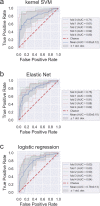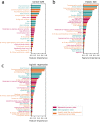Predicting positron emission tomography brain amyloid positivity using interpretable machine learning models with wearable sensor data and lifestyle factors
- PMID: 38087316
- PMCID: PMC10714506
- DOI: 10.1186/s13195-023-01363-x
Predicting positron emission tomography brain amyloid positivity using interpretable machine learning models with wearable sensor data and lifestyle factors
Abstract
Background: Developing a screening method for identifying individuals at higher risk of elevated brain amyloid burden is important to reduce costs and burden to patients in clinical trials on Alzheimer's disease or the clinical setting. We developed machine learning models using objectively measured lifestyle factors to predict elevated brain amyloid burden on positron emission tomography.
Methods: Our prospective cohort study of non-demented, community-dwelling older adults aged ≥ 65 years was conducted from August 2015 to September 2019 in Usuki, Oita Prefecture, Japan. One hundred and twenty-two individuals with mild cognitive impairment or subjective memory complaints (54 men and 68 women, median age: 75.50 years) wore wearable sensors and completed self-reported questionnaires, cognitive test, and positron emission tomography imaging at baseline. Moreover, 99 individuals in the second year and 61 individuals in the third year were followed up. In total, 282 eligible records with valid wearable sensors, cognitive test results, and amyloid imaging and data on demographic characteristics, living environments, and health behaviors were used in the machine learning models. Amyloid positivity was defined as a standardized uptake value ratio of ≥ 1.4. Models were constructed using kernel support vector machine, Elastic Net, and logistic regression for predicting amyloid positivity. The mean score among 10 times fivefold cross-validation repeats was utilized for evaluation.
Results: In Elastic Net, the mean area under the receiver operating characteristic curve of the model using objectively measured lifestyle factors alone was 0.70, whereas that of the models using wearable sensors in combination with demographic characteristics and health and life environment questionnaires was 0.79. Moreover, 22 variables were common to all machine learning models.
Conclusion: Our machine learning models are useful for predicting elevated brain amyloid burden using readily-available and noninvasive variables without the need to visit a hospital.
Trial registration: This prospective study was conducted in accordance with the Declaration of Helsinki and was approved by the local ethics committee of Oita University Hospital (UMIN000017442). A written informed consent was obtained from all participants. This research was performed based on the Strengthening the Reporting of Observational Studies in Epidemiology reporting guideline.
Keywords: Amyloid positivity; Lifestyle factors; Machine learning; Mild cognitive impairment; PiB-PET; Wearable sensor.
© 2023. The Author(s).
Conflict of interest statement
Dr. Kimura received honorarium from Eisai, Takeda Pharmaceutical, Daiichi Sankyo, Sumitomo Pharma, FUJIFILM Toyama, and Kyowa Kirin, outside the submitted work. No other disclosures were reported.
Figures




Similar articles
-
Association of Modifiable Lifestyle Factors With Cortical Amyloid Burden and Cerebral Glucose Metabolism in Older Adults With Mild Cognitive Impairment.JAMA Netw Open. 2020 Jun 1;3(6):e205719. doi: 10.1001/jamanetworkopen.2020.5719. JAMA Netw Open. 2020. PMID: 32515796 Free PMC article.
-
Effect of amyloid on memory and non-memory decline from preclinical to clinical Alzheimer's disease.Brain. 2014 Jan;137(Pt 1):221-31. doi: 10.1093/brain/awt286. Epub 2013 Oct 30. Brain. 2014. PMID: 24176981
-
Predicting Amyloid-β Levels in Amnestic Mild Cognitive Impairment Using Machine Learning Techniques.J Alzheimers Dis. 2020;73(3):1211-1219. doi: 10.3233/JAD-191038. J Alzheimers Dis. 2020. PMID: 31884486 Free PMC article.
-
Cognitive and neuroimaging features and brain β-amyloidosis in individuals at risk of Alzheimer's disease (INSIGHT-preAD): a longitudinal observational study.Lancet Neurol. 2018 Apr;17(4):335-346. doi: 10.1016/S1474-4422(18)30029-2. Epub 2018 Feb 27. Lancet Neurol. 2018. PMID: 29500152
-
A Scoping Review of the Use of Machine Learning in Health Economics and Outcomes Research: Part 1-Data From Wearable Devices.Value Health. 2023 Feb;26(2):292-299. doi: 10.1016/j.jval.2022.08.005. Epub 2022 Sep 15. Value Health. 2023. PMID: 36115806
Cited by
-
Gastric Emptying Scintigraphy Protocol Optimization Using Machine Learning for the Detection of Delayed Gastric Emptying.Diagnostics (Basel). 2024 Jun 13;14(12):1240. doi: 10.3390/diagnostics14121240. Diagnostics (Basel). 2024. PMID: 38928655 Free PMC article.
-
Machine learning models for dementia screening to classify brain amyloid positivity on positron emission tomography using blood markers and demographic characteristics: a retrospective observational study.Alzheimers Res Ther. 2025 Jan 21;17(1):25. doi: 10.1186/s13195-024-01650-1. Alzheimers Res Ther. 2025. PMID: 39838434 Free PMC article.
-
Enhancing wearable sensor data analysis for patient health monitoring using allied data disparity technique and multi instance ensemble perceptron learning.Sci Rep. 2025 Aug 12;15(1):29555. doi: 10.1038/s41598-025-08051-w. Sci Rep. 2025. PMID: 40796786 Free PMC article.
References
MeSH terms
Substances
LinkOut - more resources
Full Text Sources
Medical

